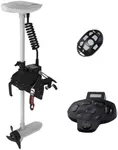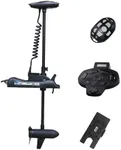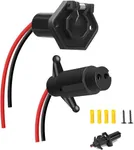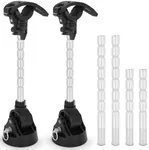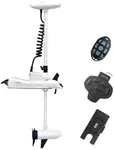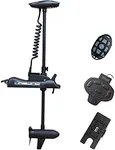Buying Guide for the Best Trolling Motors For Pontoons
Choosing the right trolling motor for your pontoon boat is essential for ensuring a smooth and enjoyable boating experience. A trolling motor helps you navigate through the water quietly and efficiently, making it ideal for fishing or leisurely cruising. To find the best fit for your needs, you should consider several key specifications that will impact the performance and suitability of the trolling motor for your pontoon. Understanding these specs will help you make an informed decision and select a motor that meets your specific requirements.ThrustThrust is the measure of how much power the trolling motor provides to move your pontoon through the water. It is usually measured in pounds (lbs). The amount of thrust you need depends on the size and weight of your pontoon. For smaller pontoons, 30-40 lbs of thrust may be sufficient, while larger pontoons may require 70 lbs or more. To determine the right thrust for you, consider the weight of your boat, including passengers and gear, and the water conditions you typically encounter. More thrust is needed for heavier loads and rougher waters.
Shaft LengthThe shaft length of a trolling motor is the distance from the motor head to the propeller. It is important because it ensures that the propeller stays submerged in the water, providing optimal performance. If the shaft is too short, the propeller may come out of the water, especially in choppy conditions. If it is too long, it can create drag and reduce efficiency. To choose the right shaft length, measure the distance from the mounting point on your pontoon to the waterline and add 16-20 inches. This will ensure the propeller stays submerged in various water conditions.
VoltageTrolling motors are powered by batteries, and the voltage indicates the number of batteries required. Common voltages are 12V, 24V, and 36V. A 12V motor uses one battery, a 24V motor uses two, and a 36V motor uses three. Higher voltage motors provide more power and longer run times but require more batteries, which adds weight and cost. For smaller pontoons or occasional use, a 12V motor may be sufficient. For larger pontoons or frequent use, consider a 24V or 36V motor for better performance and longer battery life.
Control TypeTrolling motors can be controlled in different ways, including hand control, foot control, and remote control. Hand control motors are operated with a tiller handle and are simple to use, making them a good choice for smaller pontoons. Foot control motors allow you to steer and adjust speed with a foot pedal, keeping your hands free for fishing or other activities. Remote control motors offer the most convenience, allowing you to control the motor from anywhere on the boat using a wireless remote. Choose the control type that best suits your boating style and preferences.
Mounting LocationTrolling motors can be mounted on the bow (front) or transom (rear) of your pontoon. Bow-mounted motors provide better control and maneuverability, especially in windy conditions, making them ideal for fishing. Transom-mounted motors are easier to install and are a good option for smaller pontoons or casual use. Consider where you will be using the motor most often and how you prefer to control your boat when deciding on the mounting location.
Additional FeaturesModern trolling motors come with various additional features that can enhance your boating experience. These may include GPS integration for precise navigation, autopilot for maintaining a set course, and digital displays for monitoring battery life and motor performance. While these features can add to the cost, they can also provide significant benefits, especially for avid boaters and anglers. Consider which features are important to you and how they will improve your time on the water.



